Are you planning a trip to Seoul and wondering how to get around? How To Travel To And Around Seoul is easier than you think with SIXT.VN. We provide convenient travel solutions such as airport transfers, hotel bookings, and tours to make your journey seamless. Discover the best transportation options and tips for navigating this vibrant city with ease, ensuring a memorable travel experience.
1. What is the Most Convenient Way to Travel to Seoul?
The most convenient way to travel to Seoul is by flying directly into Incheon International Airport (ICN), the largest airport in South Korea. According to research from Airports Council International (ACI), in [2023], ICN is renowned for its efficiency and services, making it a top choice for international travelers and providing seamless transit to the city center via airport trains, buses, or SIXT.VN’s private transfer services. SIXT.VN offers reliable and comfortable airport transfer services, ensuring a hassle-free start to your Seoul adventure.
1.1. Why Choose Incheon International Airport?
Incheon International Airport is consistently ranked among the best airports globally due to its exceptional facilities and services.
- Efficient Immigration and Customs: Streamlined processes ensure quick entry into the country.
- Excellent Transportation Links: Multiple options like the AREX express train, limousine buses, and taxis connect the airport to Seoul.
- World-Class Amenities: Enjoy duty-free shopping, diverse dining options, comfortable lounges, and even cultural experiences.
- SIXT.VN’s Convenient Transfers: Pre-book a private transfer with SIXT.VN for a comfortable and stress-free ride to your hotel.
1.2. What Are the Best Transportation Options from Incheon Airport to Seoul?
Upon arrival at Incheon International Airport, you have several transportation options to reach Seoul city center:
| Transportation Option | Description | Pros | Cons |
|---|---|---|---|
| AREX Express Train | Direct train service connecting Incheon Airport to Seoul Station. | Fast (43-51 minutes), comfortable, and affordable. | Limited stops (only Seoul Station). |
| Limousine Bus | Comfortable buses that take you to major hotels and districts in Seoul. | Direct routes to many locations, comfortable seating, and luggage storage. | Can be slower than the train due to traffic. |
| Taxi | Regular and deluxe taxis available outside the arrival hall. | Convenient for door-to-door service, especially with luggage. | More expensive than other options, potential traffic delays. |
| SIXT.VN Private Transfer | Pre-booked private car service with professional drivers. SIXT.VN also offers airport shuttle services. | Personalized service, fixed pricing, meet-and-greet service, and comfortable vehicles. | Higher cost compared to public transportation. |
1.3. How Can SIXT.VN Enhance Your Arrival Experience?
SIXT.VN offers a seamless and stress-free airport transfer service, ensuring you start your Seoul journey on the right foot.
- Pre-Booking: Arrange your transfer in advance via the SIXT.VN website or hotline.
- Meet-and-Greet: A professional driver will meet you at the arrival hall with a personalized sign.
- Comfortable Vehicles: Choose from a range of vehicles to suit your needs and group size.
- Fixed Pricing: No surprises with transparent and competitive rates.
- 24/7 Availability: Round-the-clock service to accommodate any flight schedule.
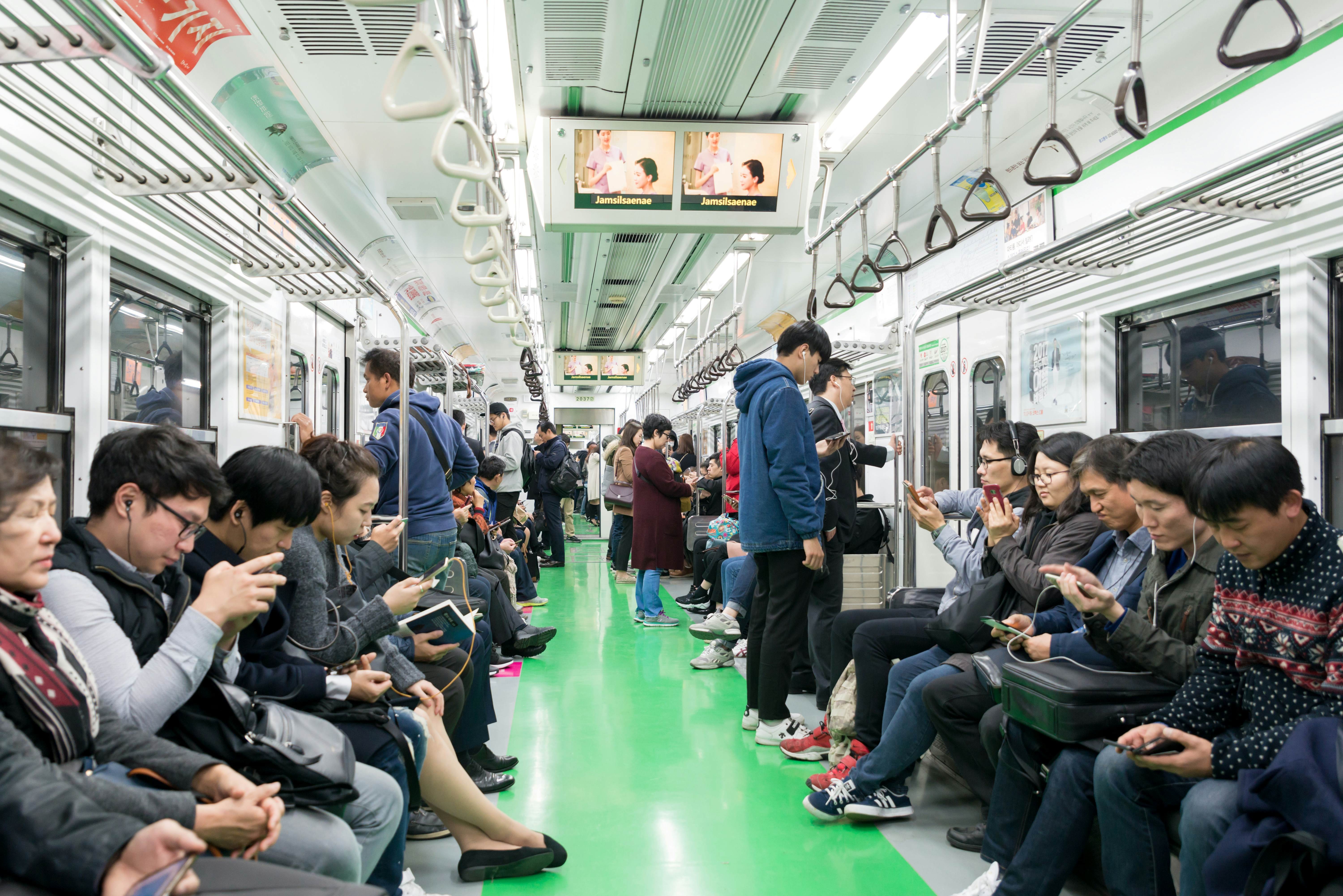 Passengers inside a metro car with many people in the seats.
Passengers inside a metro car with many people in the seats.
2. What is the Best Way to Get Around Seoul?
The best way to get around Seoul is by utilizing its extensive and efficient public transportation system, particularly the metro. According to the Korea Transport Institute in [2022], the Seoul Metropolitan Subway is one of the world’s largest and most user-friendly subway systems, connecting every corner of the city. For maximum convenience, combine the metro with buses and taxis as needed, and consider using a T-money card for easy fare payment.
2.1. Why is the Seoul Metro So Efficient?
The Seoul Metro is renowned for its efficiency and convenience:
- Extensive Network: 22 lines with over 300 stations covering the entire city and surrounding areas.
- Frequent Service: Trains run every few minutes, reducing wait times.
- Clear Signage: Stations are well-marked in Korean, English, Chinese, and Japanese, making navigation easy.
- Affordable Fares: Economical travel with a T-money card.
- Real-Time Information: Use apps like KakaoMetro for up-to-date train schedules and route planning.
2.2. How to Use the Seoul Metro Like a Pro
Follow these tips to navigate the Seoul Metro with ease:
- Purchase a T-money Card: Available at convenience stores and subway stations, this rechargeable card simplifies fare payment.
- Download a Subway App: KakaoMetro or similar apps provide real-time information and route planning.
- Plan Your Route: Use the app to find the quickest route to your destination.
- Tap In and Out: Tap your T-money card at the entrance and exit gates.
- Follow the Signs: Look for signs in English, Korean, Chinese, and Japanese.
- Be Mindful of Rush Hour: The metro can be crowded during peak hours (7-9 AM and 6-8 PM).
- Utilize Transfer Stations: Transfer seamlessly between lines by following the directional signs.
2.3. What About Seoul’s Bus System?
Seoul’s bus system complements the metro, reaching areas not directly accessible by train.
- Color-Coded Buses: Different colors indicate different routes and service areas.
- Blue Buses: Major routes across the city.
- Green Buses: Local routes connecting to subway stations.
- Red Buses: Express routes to the suburbs.
- Yellow Buses: Circular routes in downtown areas.
- Real-Time Information: Bus arrival times are displayed at bus stops and on apps.
- T-money Card: Use your T-money card for easy fare payment.
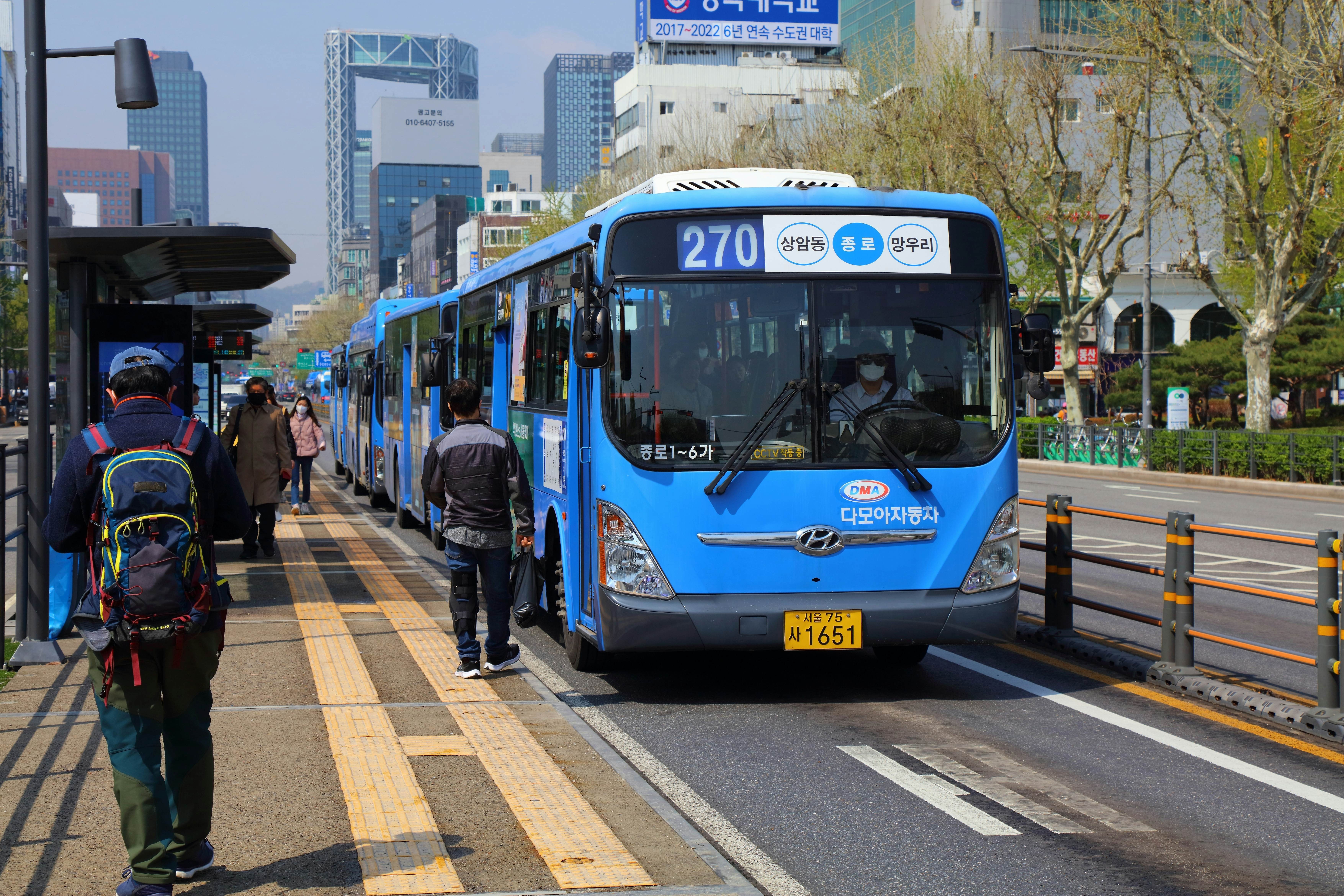 People board blue-painted buses in a dedicated bus lane.
People board blue-painted buses in a dedicated bus lane.
3. Are Taxis a Good Option for Getting Around Seoul?
Taxis are a convenient option for late-night travel or reaching specific destinations, but they are more expensive than public transportation. According to Seoul Metropolitan Government’s Transportation Bureau, taxis are readily available, especially during off-peak hours, and offer a comfortable, door-to-door service. Consider using taxi services when public transportation is limited or when traveling with heavy luggage.
3.1. Types of Taxis in Seoul
Seoul offers several types of taxis to suit different needs and budgets:
- Regular Taxis: The most common type, usually silver or orange.
- Deluxe Taxis: Black taxis offering more space and comfort, with higher fares.
- Jumbo Taxis: Larger vehicles suitable for groups or families.
- International Taxis: Drivers who speak English or other foreign languages, catering to tourists.
3.2. How to Hail a Taxi in Seoul
Hailing a taxi in Seoul is relatively easy:
- Street Hailing: Stand on the side of the road and wave at an approaching taxi.
- Taxi Stands: Find designated taxi stands near popular attractions, subway stations, and shopping areas.
- Taxi Apps: Use apps like Kakao T to book a taxi from your smartphone.
3.3. Tips for Taking a Taxi in Seoul
- Carry the Address in Korean: Show the driver the address of your destination written in Korean to avoid confusion.
- Use a Translation App: If communication is difficult, use a translation app to convey your message.
- Be Aware of Rush Hour: Taxis can be harder to find and more expensive during rush hour.
- Check the Meter: Ensure the meter is running at the start of your journey.
- Keep the Hotline Number: In case of any issues, note down the taxi number and contact the taxi company or tourist information center.
4. What About Bike Rentals and Walking in Seoul?
Bike rentals and walking are excellent options for exploring specific areas of Seoul at your own pace. According to Visit Seoul, the city has invested in bike-sharing programs and pedestrian-friendly streets, making it easier to discover hidden gems and enjoy the urban landscape. Consider using these options for leisurely exploration and sightseeing.
4.1. Bike-Sharing Programs in Seoul
Seoul offers a convenient bike-sharing program called Ttareungi, allowing you to rent bicycles at various stations across the city.
- Easy Registration: Register online or through the Seoul Bike app.
- Affordable Rates: Hourly, daily, and yearly passes are available.
- Multiple Rental Stations: Pick up and return bikes at numerous stations throughout Seoul.
- Dedicated Bike Lanes: Utilize the city’s bike lanes and trails for safe cycling.
4.2. Best Areas for Walking in Seoul
Seoul is a great city for walking, with many pedestrian-friendly areas offering unique experiences:
- Myeongdong: A bustling shopping district with pedestrian streets and vibrant street food.
- Insadong: A cultural district with traditional crafts, tea houses, and art galleries.
- Bukchon Hanok Village: A historic neighborhood with beautifully preserved traditional Korean houses.
- Gangnam: A modern district with upscale shopping, dining, and entertainment options.
- Cheonggyecheon Stream: A restored urban oasis with walking paths and scenic views.
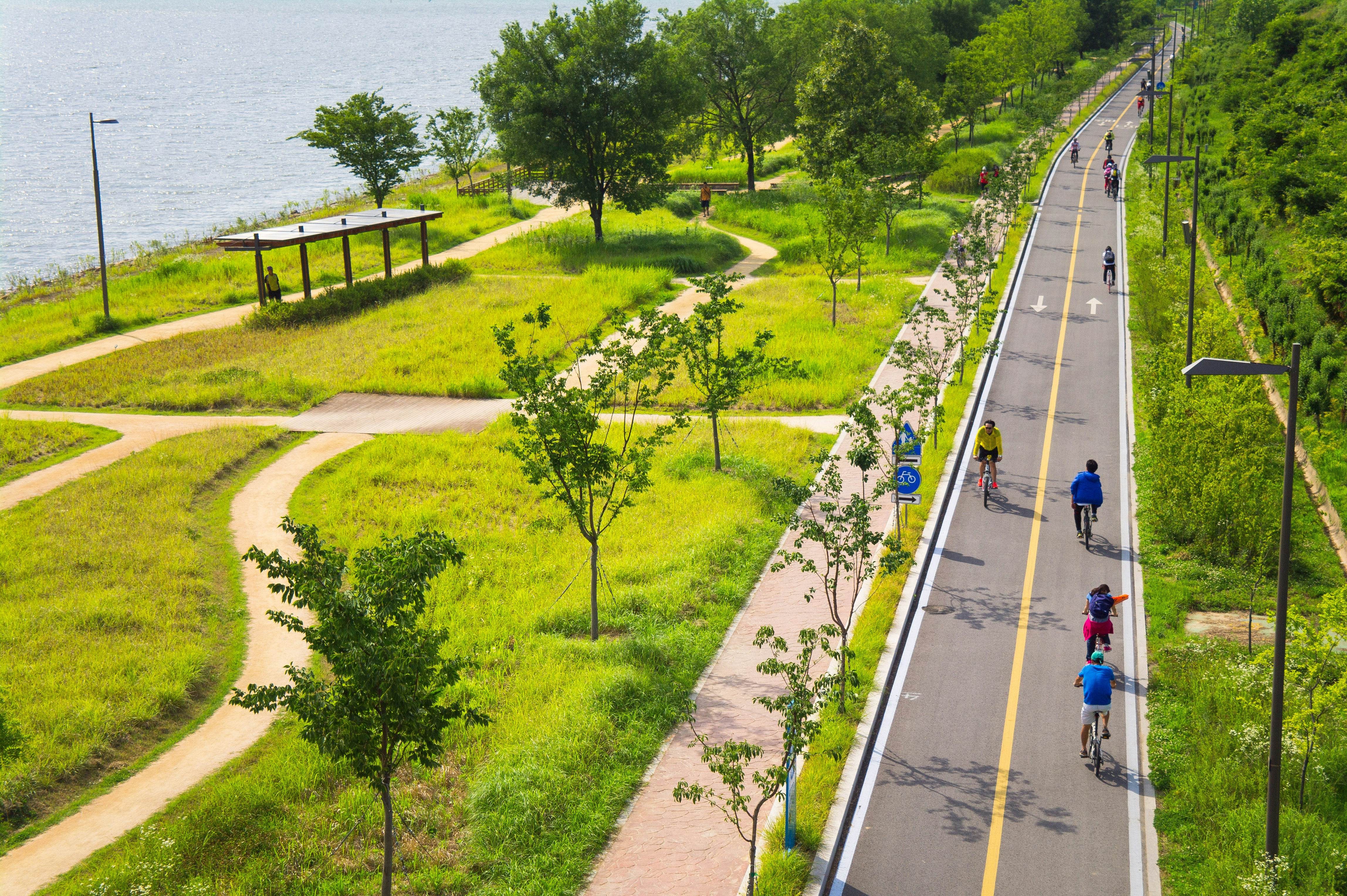 Cyclists ride along a paved bicycle path beside a river.
Cyclists ride along a paved bicycle path beside a river.
4.3. Tips for Biking and Walking in Seoul
- Wear Comfortable Shoes: Be prepared for a lot of walking, especially in hilly areas.
- Stay Hydrated: Carry water, especially during the warmer months.
- Use Navigation Apps: Use apps like KakaoMap or Naver Map to find walking and biking routes.
- Be Aware of Traffic: Pay attention to traffic signals and pedestrian crossings.
- Respect Local Customs: Be mindful of pedestrians and cyclists, and follow local etiquette.
5. How Accessible is Seoul for Travelers with Disabilities?
Seoul is increasingly becoming more accessible for travelers with disabilities, with ongoing efforts to improve infrastructure and services. According to Seoul Danurim Accessible Tourism Center, many subway stations and buses are equipped with elevators, ramps, and accessible facilities. Plan your trip with accessible transportation options and accommodations in mind for a comfortable and inclusive experience.
5.1. Accessible Transportation Options
- Subway: Most subway stations have elevators, ramps, and wheelchair-accessible turnstiles.
- Buses: Many buses are equipped with ramps or low-floor designs for easy boarding.
- Taxis: Accessible taxis are available, but it’s best to book in advance through Seoul Danurim or other specialized services.
5.2. Accessible Accommodation and Attractions
- Hotels: Many hotels offer accessible rooms and facilities for guests with disabilities.
- Attractions: Popular attractions like Gyeongbokgung Palace, N Seoul Tower, and the National Museum of Korea have accessible routes and facilities.
- Information Centers: Tourist information centers provide assistance and resources for travelers with disabilities.
5.3. Resources for Accessible Travel in Seoul
- Seoul Danurim Accessible Tourism Center: Provides information, resources, and assistance for travelers with disabilities.
- Accessible Korea: Offers travel planning services and accessible tour packages.
- WheelchairTravel.org: Provides detailed information about accessible transportation and attractions in Seoul.
6. What are the Essential Apps for Navigating Seoul?
Essential apps for navigating Seoul include KakaoMap for detailed maps and directions, KakaoMetro for subway navigation, and KakaoT for taxi booking. According to tech reviews from The Korea Herald, these apps offer real-time information and user-friendly interfaces, making it easier to get around Seoul efficiently. Consider downloading these apps to enhance your travel experience.
6.1. KakaoMap
KakaoMap is a comprehensive map app that provides detailed information about Seoul and other parts of South Korea.
- Accurate Maps: Detailed and up-to-date maps with points of interest, restaurants, and transportation options.
- Real-Time Traffic: Live traffic updates and route planning to avoid congestion.
- Public Transportation Information: Detailed information about subway and bus routes, schedules, and fares.
- Street View: Street view imagery for better orientation.
6.2. KakaoMetro
KakaoMetro is a subway navigation app that helps you plan your routes and navigate the Seoul Metro system.
- Subway Maps: Detailed subway maps with station information and transfer points.
- Route Planning: Find the quickest route to your destination with real-time information.
- Arrival Times: Real-time arrival and departure times for trains.
- Station Information: Information about station facilities, exits, and nearby attractions.
6.3. Kakao T
Kakao T is a transportation app that allows you to book taxis, ride-hailing services, and parking spaces in Seoul.
- Taxi Booking: Book a taxi with just a few taps on your smartphone.
- Ride-Hailing: Use Kakao T’s ride-hailing service for a convenient alternative to taxis.
- Parking: Find and reserve parking spaces in Seoul.
- Payment Options: Pay for your rides and parking with credit cards or Kakao Pay.
7. How Can SIXT.VN Help You Travel Around Seoul?
SIXT.VN can significantly enhance your travel experience in Seoul by providing reliable transportation solutions, convenient airport transfers, and personalized services. According to customer reviews, SIXT.VN offers comfortable vehicles and professional drivers, ensuring a stress-free and enjoyable journey around Seoul. Consider SIXT.VN for your transportation needs to experience the best of Seoul.
7.1. SIXT.VN’s Airport Transfer Services
- Meet and Greet: Professional drivers will meet you at the airport and assist with your luggage.
- Comfortable Vehicles: Choose from a range of vehicles to suit your needs and group size.
- Fixed Pricing: Transparent and competitive rates with no hidden fees.
- 24/7 Availability: Round-the-clock service to accommodate any flight schedule.
7.2. SIXT.VN’s City Transportation Services
- Private Car Service: Hire a private car with a driver for convenient transportation around Seoul.
- Flexible Itineraries: Customize your itinerary and explore Seoul at your own pace.
- Professional Drivers: Experienced drivers who know the city well and can provide local insights.
- Comfort and Convenience: Travel in comfort and style with SIXT.VN’s well-maintained vehicles.
7.3. SIXT.VN’s Tour Packages
- Customized Tours: Tailored tour packages to suit your interests and preferences.
- Guided Tours: Knowledgeable guides to show you the best of Seoul’s attractions.
- Hassle-Free Travel: Let SIXT.VN take care of all the details, from transportation to accommodations.
- Unforgettable Experiences: Create lasting memories with SIXT.VN’s expertly crafted tour packages.
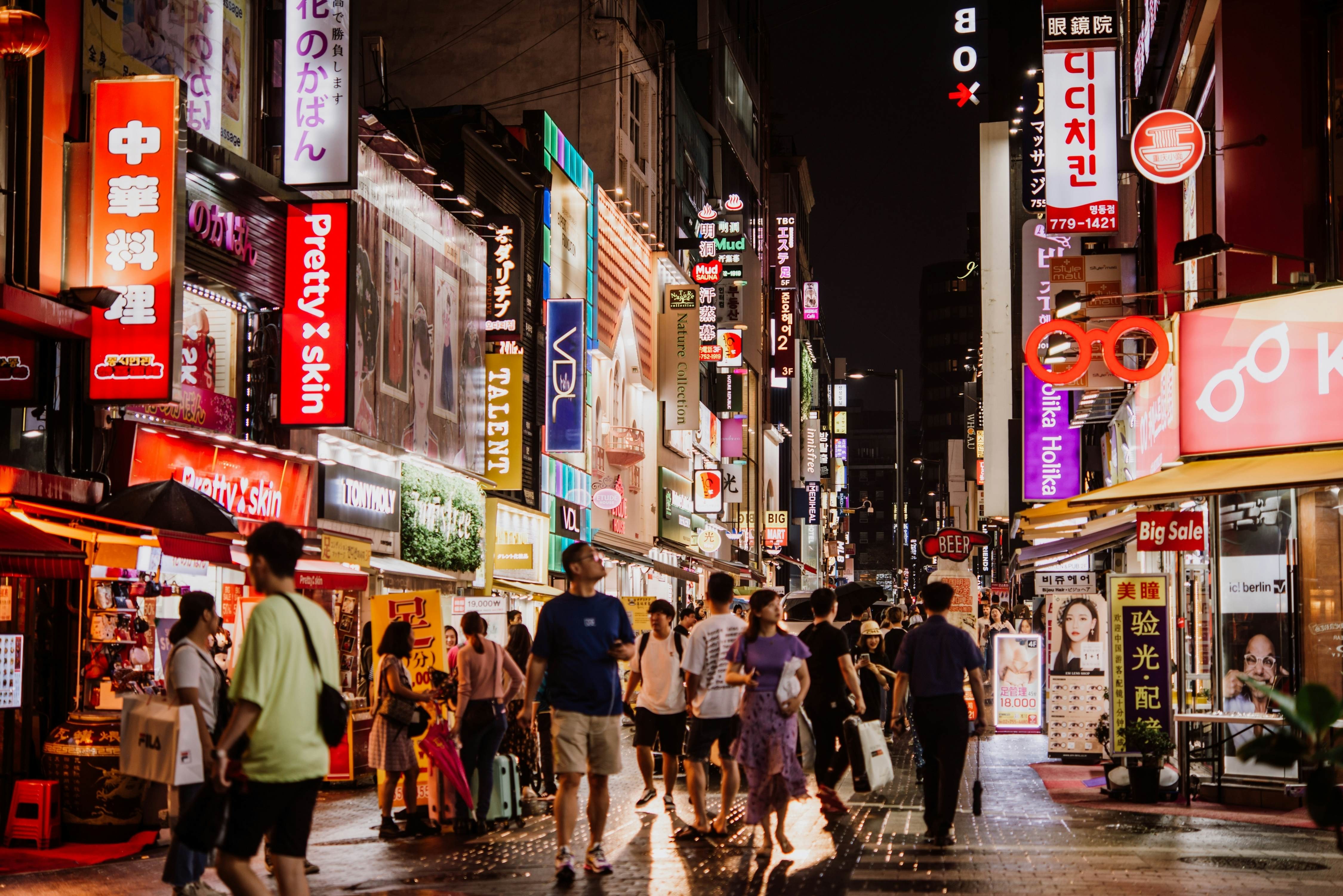 People walk on pedestrian-only street at night in a large city.
People walk on pedestrian-only street at night in a large city.
8. What are Some Tips for Saving Money on Transportation in Seoul?
To save money on transportation in Seoul, utilize a T-money card for discounted fares on public transport, avoid taxis during peak hours, and consider walking or biking for shorter distances. According to budget travel guides, planning your routes in advance and taking advantage of free transfer options can also help reduce transportation costs. Consider these tips to maximize your budget while exploring Seoul.
8.1. Use a T-money Card
- Discounted Fares: Get discounted fares on subway and bus rides with a T-money card.
- Convenient Payment: Easily pay for your rides by tapping the card at the entrance and exit gates.
- Free Transfers: Get free transfers between subway lines and buses within a certain time frame.
8.2. Avoid Taxis During Peak Hours
- Higher Fares: Taxi fares are higher during peak hours and late at night.
- Traffic Congestion: Traffic can be heavy during peak hours, making taxis slower and more expensive.
- Consider Alternatives: Use public transportation or walk during peak hours to save money and time.
8.3. Walk or Bike for Shorter Distances
- Explore at Your Own Pace: Walking and biking allow you to explore Seoul’s neighborhoods at your own pace.
- Save Money: Walking and biking are free, saving you money on transportation costs.
- Enjoy the Scenery: Walking and biking let you enjoy Seoul’s beautiful scenery and urban landscape.
9. What are the Peak Travel Times in Seoul to Avoid?
Peak travel times in Seoul typically occur during rush hour (7-9 AM and 6-8 PM) on weekdays and during major holidays. According to transportation reports, the subway and buses are most crowded during these times, leading to delays and discomfort. Plan your travel around these peak times to avoid congestion and enjoy a smoother journey.
9.1. Rush Hour on Weekdays
- 7-9 AM: Morning rush hour as people commute to work and school.
- 6-8 PM: Evening rush hour as people return home from work and school.
- Subway and Bus Congestion: Expect crowded subway trains and buses during these times.
- Traffic Jams: Traffic congestion on roads, making taxis and buses slower.
9.2. Major Holidays
- Lunar New Year (Seollal): One of the biggest holidays in Korea, with many people traveling to visit family.
- Chuseok (Korean Thanksgiving): Another major holiday with heavy travel volume.
- Public Holidays: Expect increased travel during long weekends and national holidays.
- Book in Advance: Book transportation and accommodations in advance during these peak travel times.
10. What are the Cultural Considerations for Using Transportation in Seoul?
Cultural considerations for using transportation in Seoul include respecting priority seating for the elderly, pregnant women, and disabled individuals, and avoiding loud conversations on public transport. According to cultural etiquette guides, maintaining a quiet and respectful demeanor is appreciated, reflecting Korean values of politeness and consideration for others. Be mindful of these cultural norms to ensure a pleasant and respectful travel experience.
10.1. Priority Seating
- Designated Seats: Priority seats are usually located at the ends of subway cars and buses.
- Respectful Behavior: Refrain from using these seats unless you are elderly, pregnant, or disabled.
- Offer Your Seat: If someone in need boards the train or bus, offer your seat to them.
10.2. Noise Levels
- Quiet Conversations: Avoid loud conversations on public transport.
- Phone Etiquette: Keep your phone on silent or use headphones when listening to music or watching videos.
- Respectful Demeanor: Maintain a quiet and respectful demeanor to avoid disturbing other passengers.
10.3. General Etiquette
- Queueing: Line up in an orderly fashion when boarding buses and trains.
- Personal Space: Be mindful of personal space and avoid crowding other passengers.
- Eating and Drinking: Refrain from eating and drinking on public transport.
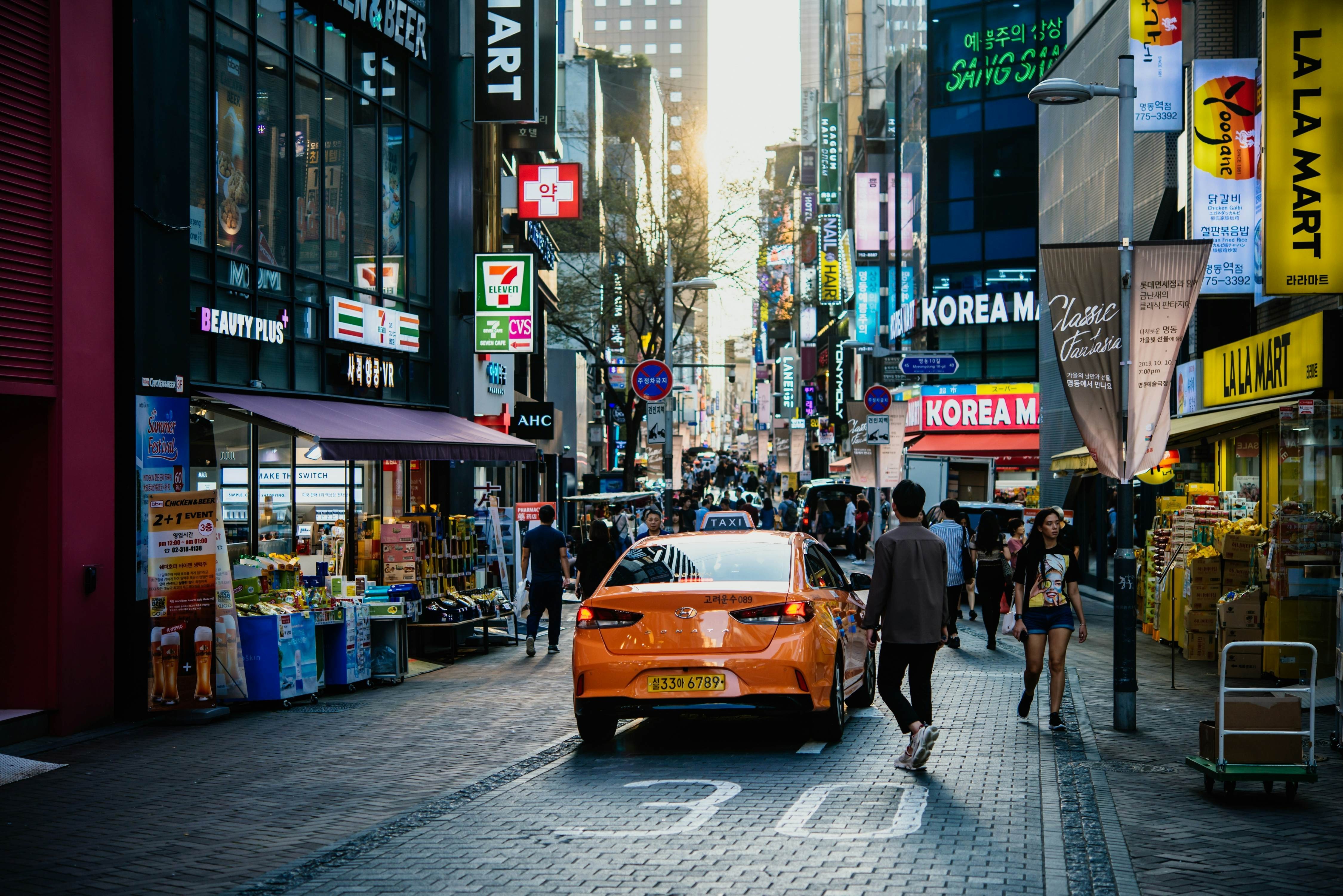 An orange taxi drives into a narrow street crowded with pedestrians.
An orange taxi drives into a narrow street crowded with pedestrians.
Ready to explore Seoul with ease? Let SIXT.VN take care of your transportation needs. Book your airport transfer, private car service, or customized tour package today and experience the best of Seoul with comfort and convenience. Contact us at Hotline/Whatsapp: +84 986 244 358 or visit our website at SIXT.VN to start planning your Seoul adventure now!
FAQ Section
1. Is it easy to travel around Seoul without speaking Korean?
Yes, it’s easy to travel around Seoul without speaking Korean. The city’s public transportation system has signs in English, and many locals speak English, especially in tourist areas.
2. What is the best transportation option for getting from Incheon Airport to Gangnam?
The best transportation option for getting from Incheon Airport to Gangnam is either a limousine bus or a pre-booked airport transfer with SIXT.VN for comfort and convenience.
3. How much does a T-money card cost, and where can I buy one?
A T-money card costs around ₩2,500 and can be purchased at convenience stores and subway stations.
4. Are there any discounts for using public transportation in Seoul?
Yes, using a T-money card provides discounted fares on subway and bus rides.
5. Is it safe to take a taxi in Seoul at night?
Yes, it is generally safe to take a taxi in Seoul at night, but it’s always a good idea to be aware of your surroundings.
6. Can I use my international driver’s license to rent a car in Seoul?
Yes, you can use your international driver’s license to rent a car in Seoul, but driving in the city can be challenging due to traffic congestion.
7. Are there any bike rental services available in Seoul?
Yes, Seoul offers a bike-sharing program called Ttareungi, with rental stations throughout the city.
8. What should I do if I get lost while using public transportation in Seoul?
If you get lost, ask a local for help or use a navigation app like KakaoMap or KakaoMetro to find your way.
9. Are there wheelchair-accessible options for getting around Seoul?
Yes, many subway stations and buses are equipped with elevators, ramps, and accessible facilities.
10. How can SIXT.VN help me plan my transportation in Seoul?
SIXT.VN offers airport transfers, private car services, and customized tour packages to help you plan your transportation in Seoul, ensuring a comfortable and stress-free experience.



